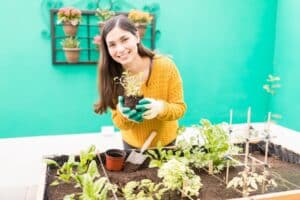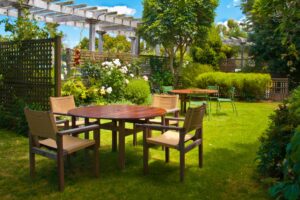Indoor Plants and Watering

Watering is essential to the life of your indoor plants. It’s one of the key ingredients to keeping them happy and healthy.
Plants that grow outdoors get much of their water naturally, though they will still need to be watered in the warmer, drier months. Read our step-by-step guide to watering your plants here.
Indoor plants don’t have the luxury of being rained on. Keeping your indoor plants happy and thriving requires a slightly deeper knowledge of your plant’s watering needs. That’s why our team of gardening experts have put together this comprehensive guide to watering your indoor plants.
One thing to keep in mind… Every plant is different. Always make sure to check and follow the care instructions that come with your specific plant. However, understanding the basics of indoor plant watering is the first step to growing and enjoying happy, healthy plants!
Why your indoor plant needs water.
Like humans, plants are mostly made up of water, and they need to drink it regularly to stay healthy.
Around 90% of a plant’s cellular structure is made of water – it’s what fills the plant cells and keeps them rigid and upright. Without a steady supply of H2O, these cell structures will quickly begin to break down and sag.
Water also helps plants perform a number of essential functions that they need to survive. For one, it helps absorb nutrients and circulate them around the plant. Extracting glucose from water is an integral part of their photosynthesis process (the conversion of sunlight to nutrients) and it also helps them maintain and regulate their ideal temperatures
This is true of every plant – even the ones that have evolved to need very little water. Like every living thing on earth, plants just need water to survive.
Overwatering is a more common issue than underwatering.
This is our number one tip to keep in mind for people who are new to watering indoor plants.
Most of us learn from a young age that plants need water, and someone who is new to caring for plants is likely to water their plant regularly and enthusiastically.
This constant watering comes from a good place, but it isn’t always the best idea. Overwatering is actually the most common reason that indoor plants die off. As a rule, most plants will prefer it if you let the soil dry completely before watering again. Always test the first few centimetres of soil with your fingers before watering. If it’s wet or damp, don’t water it.
Plant roots need oxygen just as much as they need water, and soil that is wet all the time won’t let enough oxygen through, causing your plant to quite literally drown. Too much constant moisture can also cause root rot and create a damp environment for diseases, mould and pests to flourish.
The best way to avoid this is to invest in pots with good drainage and err on the side of caution when you first get your plant, especially for dry-climate plants like cacti. Keep an eye out for yellowing or wilting leaves, soft stems and foul, damp odours – these are the most common signs of overwatering.
Remember to always check the first few centimetres of soil with your fingers. If it is always damp, you are likely overwatering. Watering your indoor plants in the mornings is also a good idea. It will give the water a better chance to soak in properly, and to naturally evaporate throughout the course of the day.
How to know when your indoor plants need water
Checking the first few centimetres of soil with your fingers is the best way to tell when your plant is thirsty. You can also squeeze some in your palm for the same results.
If the soil is dry and crumbly, it’s time for a drink. Already wet and sticky? Then you probably shouldn’t water it. Lightly moist soil means it’s at the perfect level right now. This simple, old-school technique is still what most experienced gardeners rely on to get the moisture right.
Your plant will generally let you know if it is feeling unhealthy. Wilted leaves, discolouration and a general sad vibe are the biggest giveaways. But as you may have noticed, these are almost the same as the signs for overwatering!
That’s why the best thing to do is check your soil – it’s one of the most accurate markers of the level of moisture in your indoor plant.
4 tips for watering your indoor plants effectively.
There are lots of ways to water indoor plants easily, without making a mess. We’ve listed some of our favourite techniques and tips below:
- Water the soil, not the leaves. It is good to get your whole plant wet sometimes, but the roots are where most of the water absorption actually happens. That means it’s important to water your plant so that the water seeps down properly into the soil. Aiming your watering can at the base of the plant also helps you to avoid splashing water everywhere whilst indoors.
- Water from Below. Many gardeners swear by this method, and it’s particularly great for indoor plants with stems that are sensitive to water. Place a tray full of water beneath your pot and let the water soak up into the roots via the drainage holes. Keep refilling the tray until it won’t absorb any more, and then remove. Simple, clean and effective.
- Placing stones or pebbles over your soil is a good solution if you find that water evaporates too quickly from your indoor plant, or if you’re growing something that likes to stay moist. That’s because the stones trap the water in the soil, keeping it moist for longer. They also repel pests like gnats and help stop dirt from spreading or spilling onto your floor.
- Wicking is a great low-effort method for watering your indoor plants while you are away from home. It involves inserting a length of twine or string deep into your soil and then placing the other end in a container of water. The string will absorb the water from the container and slowly transfer (or ‘wick’) the water to your plant over a number of days. You can read the WikiHow on Wicking for a quick guide.
Is tap water okay for my indoor plants?
Good question! Many plant owners may not have considered whether the water they’re giving to their plants is actually appropriate.
‘Hard’ tap water that still contains natural minerals is considered good for most plants, though water that is very hard may cause problems. However, most people agree that ‘Soft’ or treated tap water is not healthy for your garden.
This is because softened water has usually been treated with sodium. This can cause high levels of salts to build up in your soil, which will confuse and dehydrate your plant. Chlorinated tap water is safe for most plants, but not ideal for some. Rainwater and filtered water are generally your best options.
Australia is a very dry country, so the quality of tap water and the amount of softening additives it includes can vary greatly between different cities and regions. Victoria and Melbourne have fairly soft water, so if you notice your more sensitive plants are struggling, the sodium levels of the tap water could be why.
The good news is that you don’t need to install a huge rainwater tank or do anything drastic. Just remember to put your watering can or a few open containers outside when it rains. A basic filtration system is also a viable and affordable option for most budding gardeners. You can also flood out or ‘leach’ salt deposits from your soil with a heavy watering.
Common Dry and Wet Indoor Plants
As we’ve mentioned, every indoor plant is different. It would be impossible for us to list all the different watering needs of every type of plant, and you’d probably fall asleep trying to read it!
However, it can still help to have a working knowledge of common dry and wet indoor plant types. This can help you choose a plant that you’ll be able to look after.
- Indoor Plants that love to be dry include Zanzibar Gem, Mother-In-Law’s Tongue, and various cacti and succulents. The trick is to consider the plant’s natural climate in the wild. If it normally grows somewhere dry and drought-stricken, like the desert, then it’s usually a dry-loving plant that needs less frequent watering than other plants.
- Indoor plants that love a lot of moisture generally hail from tropical areas and rainforests where it is always wet. These plants are hard to overwater and includes most of the popular ferns. These plants are good for a bathroom, or if you’re worried that you might be the type to overwater.
There is such a wide away of indoor plants out there – after all, an ‘indoor plant’ is any plant that you can keep indoors – so it’s always important to check the specific care instructions for the plant that you’re bringing home.
By following the general watering tips and information set out in this guide, you’ll be on the road to growing a huge, healthy indoor garden in no time!
Anyone can learn to be a natural green thumb with a little bit of time, love and care. Check out our diverse range of beautiful indoor plants at Diacos today to get your indoor garden started.
-
 13, Jun, 2025
13, Jun, 2025How to Start a Garden Design Project: Step-by-Step Planning Guide for Beginners
At Diaco’s, we know that creating a beautiful garden starts... -
 27, May, 2025
27, May, 2025Smart Garden Layout Ideas: How to Maximise Your Outdoor Space
At Diaco’s, we believe every garden has potential. Whether you’ve... -
 9, May, 2025
9, May, 20257 Garden Design Principles to Transform Your Outdoor Space
At Diaco’s, we know that creating a garden isn’t just...


